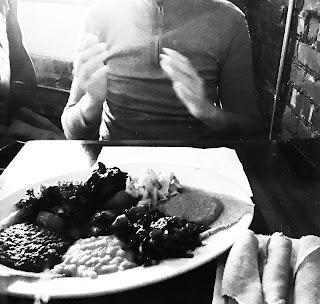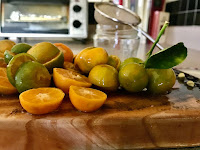
 |
| Bunna Café, Bushwick, Brooklyn, c.a. 2017, photo by I.G. |
The title of this post is directly borrowed from a recent food article in The Times by Dorie Greenspan writing about (and the recipe for) a cake salé. Her prose-wording is beautiful and personal it evokes a home kitchen that’s lived in by a bon vivant cook loving the artisanal process and loving the poetic at the same punch. She said that while mixing the dry ingredients into the wet batter to “turn a blind eye to thoroughness,” so in the kneading and molding of the cake mixture when transferred to a lined (or buttered) loaf pan will emanate on its own the “benevolent neglect” — and rise for you. In the least, that’s my understanding on the cross-section between baking and writing, and seeing awesome food-making how I “read” it. Greenspan is an American living in Paris. Vicariously reading, I am reminiscing my good old market runs and cooking in this artistic city.
But New York, as it was, had always been my kind of Paris where I could be a flâneur as much as a passionately-charge twin soul when it comes to cooking for your lifestyle. Bushwick was the emerging “beat generation” neighborhood in Brooklyn when I first moved to the city a decade ago, and it was an industrial den of retrofitted factory buildings turned artist lofts/galleries and bodegas becoming splendid chef-owner restaurants and food bars (Roberta’s, Shinobi and Bunna Café come to mind). Just like the 11th district in Paris, Bushwick is a hipster enclave with a food scene vibe that’s downright supernatural. There is a line in Puccini’s opera “La Bohème” that begs the question “What does a poet do?” [in this context], and the answer is: “He lives!” So many aspiring chefs at that time would live to cook and learn at any of these gastronomy havens, and I was fortunate to have briefly trained in one. (I said I would work for free one summer, like the notion of a vagabond gourmet to write for food.)
Chef Sean, of Shinobi, still an acquaintance, taught me a lasting principle of the inviability of food without its tactile relationship to his creator. Let it go, he said, and let it live on the plate. You maximize the diner's experience by cooking the food yourself, from beginning to end, your one server will take your artful ramen to the communal table, you nod for the triumph that’s before you as a sign of respect, and know its creator is still working away in his open kitchen yet could never take you for granted. And that’s the measure of benevolent neglect.





Social icons